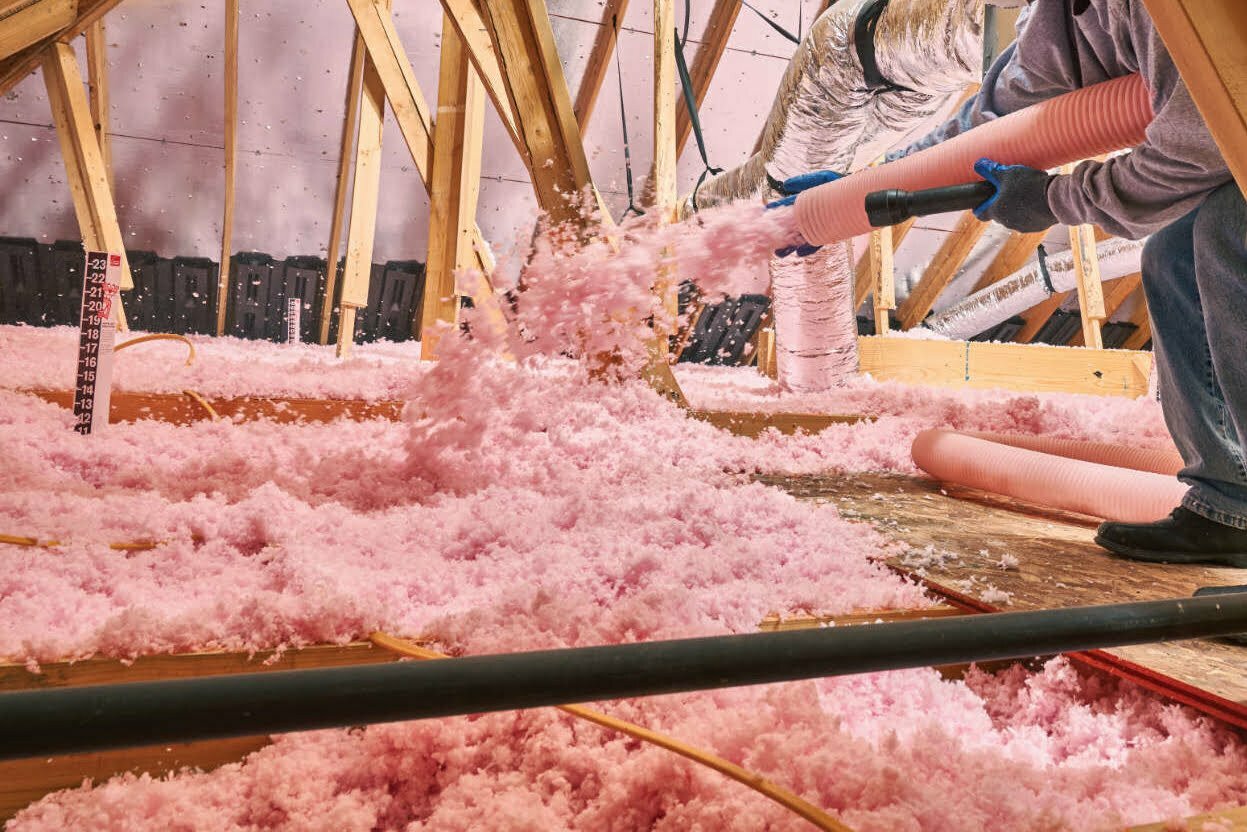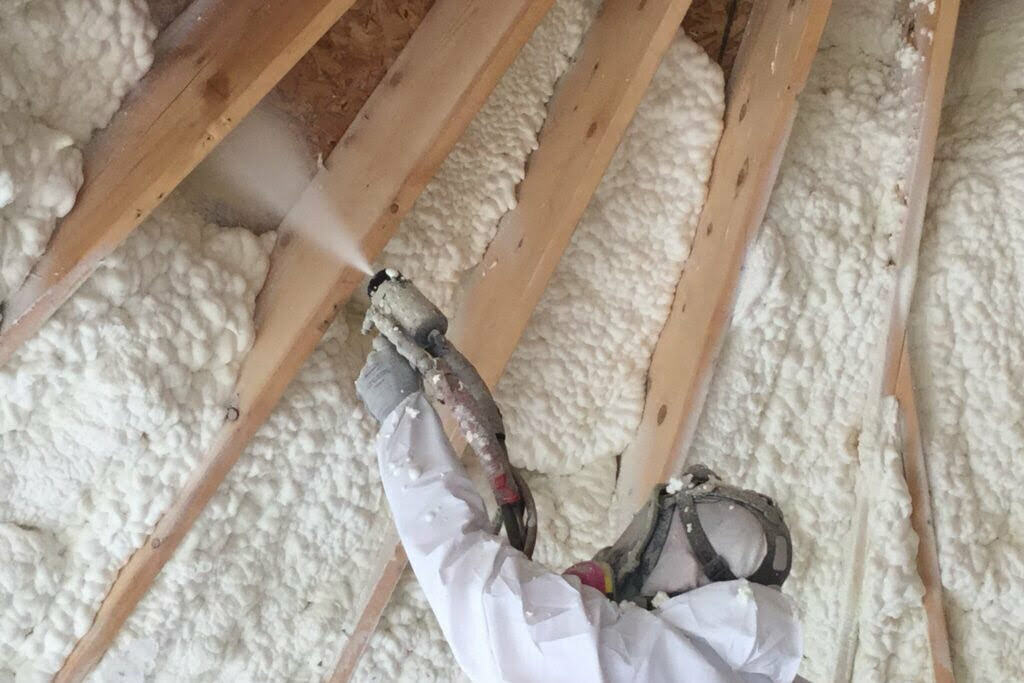Understanding the differences between various insulation types can overwhelm homeowners and builders. With many options, it can be challenging to decide the best choice for your project.
Two of the most popular insulation types are blown-in and spray foam. Each type has its benefits and is suitable for specific uses, and understanding these can help you make an informed decision.
Diving into the World of Blown-in Insulation
Blown-in insulation, also known as loose-fill insulation, is a type of insulation material typically installed in attics, walls, and other areas of a building to improve its thermal and energy efficiency. This insulation is called “blown-in” because it is typically installed by blowing or spraying the insulation material into the desired space using special equipment. Blown-in insulation is primarily made from fiberglass, cellulose, or mineral wool.
How Blown-in Insulation Works
Blown-in insulation is installed using a machine that breaks down bales of fiberglass or cellulose materials. A second component of the machine blows the material into insulated spaces like attics or wall cavities between existing wall studs and ceiling joists.
Blown-in insulation tends to settle downward by a few inches over time. This leaves a small section at the top of the stud space uninsulated, which ultimately reduces the R-value.
Key Benefits of Blown-in Insulation
One of the biggest advantages of blown-in insulation is its energy efficiency. When properly installed by certified attic specialists, you can expect to see a reduction in your energy bills. Another benefit of this insulation material is its flexibility in filling all spaces, including tiny crevices and off-beat areas, ensuring comprehensive insulation.
Potential Drawbacks and Considerations of Blown-in Insulation
The installation process of blown-in insulation does require specialized equipment and a professional installer. As such, it may not be an ideal option for a weekend DIY project. On top of that, its ability to provide soundproof insulation might be considered less effective compared to foam insulation. However, when properly installed, this insulation can provide decades of quality thermal resistance that helps keep your home comfortable year-round.
Unraveling Spray Foam Insulation
Spray foam insulation is a type of insulation material applied as a liquid and then expands into a foam to create an airtight and insulating barrier. It is used to seal and insulate various building areas, including walls, ceilings, roofs, and attics. Spray foam insulation is known for its excellent insulating properties and ability to create a seamless, airtight seal.
The Science Behind Spray Foam Insulation
Spray foam insulation is a two-part component foam that comes as a closed-cell or open-cell product. When applied, it mixes at the nozzle and comes out at a much higher velocity. Then, it expands rapidly and adheres to whatever surface it’s sprayed onto. Spray foam is ideal for applications such as treating the joist ends of a basement, a crawl space ceiling, or exposed walls. Note that spray foam cannot be sprayed into closed wall cavities because it expands too fast and thick.
Pros and Cons of Spray Foam Insulation
Spray foam insulation excels in providing a high R-value, a measure of thermal resistance, yielding significant energy savings on heating and cooling. It also creates an effective moisture barrier and significantly improves indoor air quality. However, it’s important to note that this insulation cannot be used for closed wall cavity spaces.
Costs Involved with Spray Foam Insulation
The costs of spray foam insulation can vary. Many factors can influence the final bill, like the size of the area to be insulated, the foam’s thickness, and the specific type of foam used. On average, open-cell foam is cheaper and provides a lower R-value. As an informed consumer, it is essential to consider not just the upfront expenses but also the long-term returns in terms of energy efficiency and lower utility bills.
Comparing Blown-in and Spray Foam Insulation
Comparison of Insulation Values
The insulation material’s value is crucial as it determines energy efficiency in relation to the square foot. The higher the value, the better the material is at insulating the property.
Spray foam insulation offers greater insulation value. While blown-in fiberglass insulation provides a value of approximately 2.2-2.7 per inch, spray foam has a whopping value of 6.0-7.4.
Price Comparison: Blown-in vs Spray Foam
The installation process affects the cost of both types. With blown-in insulation, the cost is typically less, from the pricing of the insulation material to the labor costs involved in its installation.
Even though insulation removal is more expensive with spray foam, long term, you’re likely to save more on energy bills and maintenance costs because of its higher energy efficiency. However, note that spray foam insulation is not suited for all parts of your home. In areas where this insulation cannot be placed, blown-in insulation may be an effective alternative.
Lifespan, Maintenance, and Efficiency: Which is Better?
The lifespan of insulation also varies depending on the material. Blown-in insulation can last for 20-30 years, while spray foam outlasts most other types with a life expectancy of over 80 years.
To maintain your insulation for the long term, it’s important to perform inspections to spot leaks or gaps. If you work with a professional insulation company, they can help determine if any insulation areas may need to be redone or restored.
Factors to Consider When Choosing Between Blown-in and Spray Foam Insulation
Choosing between blown-in and spray foam insulation involves considering several factors to determine which option is best suited for your needs and budget. Here are some key factors to consider when making this decision:
- Insulation Goals: Determine your primary objectives for insulation. Are you primarily looking to improve energy efficiency, enhance soundproofing, prevent moisture intrusion, or a combination of these factors? The specific goals can influence your choice.
- R-Value Requirements: Consider the recommended or required R-value for your region and the area you’re insulating. Closed-cell spray foam typically has a higher R-value per inch compared to most blown-in insulation materials, so if achieving a high R-value in a limited space is crucial, spray foam may be more appropriate.
- Installation Area: The location where you plan to install insulation can influence your choice. For instance, spray foam is well-suited for sealing and insulating irregularly shaped or hard-to-reach spaces like crawl spaces, while blown-in insulation is often used in attic insulation and wall cavities.
- Moisture Resistance: If you’re concerned about moisture intrusion, especially in areas like basements or crawl spaces, closed-cell spray foam is a good choice, as it acts as a moisture barrier. Blown-in insulation may require additional moisture control measures.
- Soundproofing Needs: Consider your soundproofing requirements. While both types of insulation can contribute to sound reduction, open-cell spray foam is denser and provides better sound-deadening capabilities.
- Professional Installation: Both blown-in and spray foam insulation should be installed by experienced professionals. Ensure you hire a qualified contractor with a good reputation for the type of insulation you choose.
Ultimately, the decision between blown-in and spray foam insulation should be based on a combination of these factors, as well as your specific needs and priorities. It’s advisable to consult with insulation professionals who can assess your home or building and provide recommendations based on your unique circumstances.
If you’re looking to work with qualified insulation experts, look to Cincinnati RetroFoam. Since 2015, we’ve provided outstanding insulation services that you simply cannot find elsewhere. We offer blown-in, spray foam, and injection foam services. Request your free quote today to get started.


